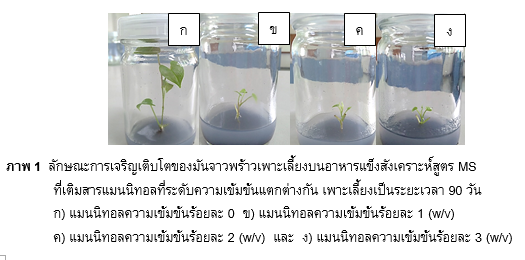In vitro growth of Dioscorea alata L. by different concentrations of mannitol
Keywords:
Slowing growth, mannitol, Dioscorea alata L.Abstract
The study was aimed to determine in vitro growth of Dioscorea alata L. by different concentrations of mannitol for the optimum medium on slowing growth for conservation of D. alata L. in vitro. Nodal segments were cultured on solid MS (Murashige and skoog, 1962) with the addition of mannitol at different concentrations of 4 levels: 0, 1, 2 and 3 % (w/v) of culture at a temperature of 25 ± 2 °C light for 16 hours a day, the light intensity of 2,500 lux cultured for 90 days without any subculture. Number of shoots, nodes and leaves per plant, percentage of root formation, and shoot length were recorded. The results investigated that 2% (w/v) mannitol was obtained the lowest of number of shoots per plant, percentage of root formation, and shoot length. While, 3% (w/v) of mannitol gave the lowest of number of nodes and leaves, respectively.
References
Makiyah S N N, Djati M S. Potency of purple yam (Dioscorea alata L.) as an immunomodulatory agent. Berkala Kedokteran. 2018;14(1):89-98.
Bahadur B, Rajam M V, Sahijram L, Krishnamurthy K V. In vitro conservation of plant germplasm. Plant Biology and Biotechnology Volume II: Plant Genomics and Biotechnology, Edition: 1st, Chapter, Publisher: Springer Veralag, New York. 2015; p.417-443.
Murashige T, Skoog F. A revised medium for rapid growth and bioassays with tobacco tissue cultures. Physiol Plantarum. 1962;15 (3):473-497.
Khalid AK, Weiming C. The effects of mannitol and salinity stresses on growth and biochemical accumulations in lemon balm. Acta Ecol Sinica. 2011; 31(2):112-120.
Mahmoud A H M, Taghreed A I. Enhanced in vitro production of Ruta graveolens L. coumarins and rutin by mannitol and ventilation. Plant Cell Tissue Organ Cult. 2012;111(3):335-343.
Sabah M H, Kadhim M I, Shatha I Y. Effect of shock and elevated levels of mannitol on callus growth, regeneration and proline accumulation in Ruta graveolens cultures. Int J Curr Microbiol App Sci. 2014; 3(11):479-488.
Matin G, Danial K, Gholamreza B. Effect of mannitol on some morphological characteristics of in vitro stevia rebaudiana Bertoni. Biharean Biol. 2017;11(2):94-97.
Lersrutaiyotin R, Roongruengchanchai N, Chindonnirat J, Burikam S, Wongmanirot M. Growth of sugarcane plantlets on media limiting concentration of inorganic nutrient and growth promoter supplement. Kasetsart J Nat Sci. 1993;27:4-8.
Golmirzaie A, Toledo J. Noncryogenic, long-term germplasm storage. In:Hall RD. editor. Methods in Molecular Biology, Vol. 111: Plant cell culture protocols. Totowa: Humana Press Inc. 1999; p. 95-101.
Helena L, Dick V. Uptake of mannitol from the media by in vitro grown plants. Plant Cell Tissue Organ Cult. 1996;45(2):103-107.
Chanprame S. Growth suppression of sugarcane and wild cane in vitro culture. Proceedings of 29th Kasetsart University Annual Conference: Plants; 1991 Feb 4-7; Bangkok, Thailand; 1991:575-581.
Pornpan S. In vitro Conservation of Dendrobium scabrilingue Lindl. Master of Science in Horticulture. Maejo University; 2006. 121 p.
Charoensub R, Phansiri S. In vitro conservation of rose coloured leadwort: Effect of mannitol on growth of plantlets. Proceedings of 42nd Kasetsart University Annual Conference: Plants. Agricultural Extension and Communication; 2004 Feb 3-6; Bangkok, Thailand; 2004:553-559.

Downloads
Published
How to Cite
Issue
Section
License
Copyright (c) 2020 Naresuan Phayao Journal

This work is licensed under a Creative Commons Attribution-NonCommercial-NoDerivatives 4.0 International License.
ผู้นิพนธ์ต้องรับผิดชอบข้อความในบทนิพนธ์ของตน มหาวิทยาลัยพะเยาไม่จำเป็นต้องเห็นด้วยกับบทความที่ตีพิมพ์เสมอไป ผู้สนใจสามารถคัดลอก และนำไปใช้ได้ แต่จะต้องขออนุมัติเจ้าของ และได้รับการอนุมัติเป็นลายลักษณ์อักษรก่อน พร้อมกับมีการอ้างอิงและกล่าวคำขอบคุณให้ถูกต้องด้วย
The authors are themselves responsible for their contents. Signed articles may not always reflect the opinion of University of Phayao. The articles can be reproduced and reprinted, provided that permission is given by the authors and acknowledgement must be given.







